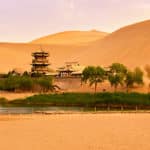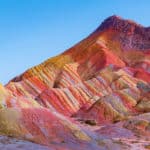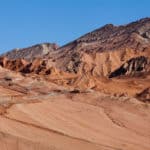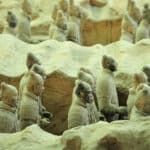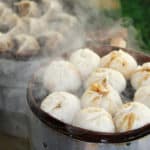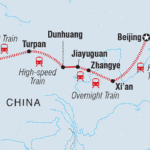China's Silk Road
Discover the treasures of the Silk Road on this 15-day adventure through China, retracing part of the ancient trade route that linked East and West. An epic journey from bustling Beijing to the frontier city of Kashgar, travel by train across diverse and beautifully rugged landscapes to see some of the country’s most spectacular relics. From dynastic palaces and Muslim minarets to hidden grottoes and rock-cut Buddhist masterpieces, this is an unforgettable Eastern odyssey.
14 days, from
$3,205
per person
GROUP SIZE
ACTIVITY LEVEL
Details
Countries Visited:
China
Accommodation: Hotel (10 nights), Guesthouse (1 nt), Overnight Sleeper Train (2 nights)
Transportation: Overnight Sleeper Train , Private Bus , Public Bus , High Speed Train , Subway , Taxi
Group size: Minimum 1, Max 12
Minimum Age: 15
Follow the route of the ancient Silk Road, travelling in the footsteps of countless generations of nomads and traders
Discover the unreal, ancient rainbow-coloured landscape of Zhangye, a UNESCO site that looks like countless pots of bright paint have been spilled across sandstone mountains. You won't be able to put your camera away!
Learn about the rapid development happening in western China as you travel between ancient regional centres and modern cities.
Ride a camel across the sand dunes in Dunhuang in search of Crescent Lake, a desert oasis that has to be seen to be believed.
Visit the frontier town of Kashgar and take in the animal market before sipping tea at a 100-year-old tea house.
Explore the famous Mogao Caves, which have been called home by Buddhist monks since the fourth century AD.
Itinerary
Nimen Hao! Welcome to Beijing - the capital of the most populous country on earth. China's capital is quickly shedding its historical face in favour of modernity, however there are still plenty of places that give an insight into the nation's ancient past, as well as sights that showcase China's contemporary culture. Your adventure begins with a welcome meeting at 6pm today, where your insurance and next of kin details will be collected. Please look for a note in the hotel lobby or ask the hotel reception where the meeting will take place – if you're going to be late, please inform the hotel reception. Any free time today in Beijing is taken at your leisure, so get out and start exploring this vast and amazing city. It's recommended that you arrive a few days early to experience all that Beijing has to offer. Beijing's food is a highlight, from the famous Beijing Roast Duck to dumplings in a tiny backstreet eatery, there’s no chance you’ll go hungry here!
Catch the bullet train to Xi'an (approximately 5-6 hours). Once the imperial centre of China for 2,000 years, Xian is now a vibrant, modern city dotted with many interesting historical sites to explore. Enjoy a walking tour of the Muslim Quarter of Xi'an with your group. After the walking tour, why not visit the Great Mosque, one of the most important in China. This area has plenty of interesting shops, lively street stalls and roving groups of white-bearded men in skull caps. This evening enjoy some free time to uncover what was once the start of the ancient trading route of the Silk Road.
Enjoy a free day to explore Xi'an at your leisure. Perhaps hire a bike and ride along the city walls, which are the most complete in China, or climb to the top of the Bell and Drum towers for impressive views. Perhaps visit the impressive Tang Dynasty Small or Big Wild Goose Pagodas. The Big Wild Goose Pagoda is in a scenic area which also includes the Shaanxi History Museum and Da Cien Temple. It's very popular with locals, especially in the evenings when there is a nightly light and music show around the many fountains. The Small Wild Goose Pagoda is inside the Jianfu Temple and Xi'an Museum is also nearby.
Today you’ll journey out in to the countryside surrounding Xi’an (approximately 2 hours) and visit what is undoubtedly one of the man-made wonders of the world – the Terracotta Warriors. You’ll learn all about this incredible archaeological find, discovered after being buried for 2,000 years by farmers digging a well in 1976. These clay statues of soldiers, horses and chariots (and originally individually painted) were commissioned by the emperor Qin Shi Huangdi as part of his mausoleum after he ascended to the throne in 264 BC. Three main pits are open for you to view, where over 1,000 warriors are displayed – each individually sculpted from clay, each having a different costume, height, and even facial expressions – stand in battle formation. The scale is incredibly impressive.In the evening the group boards the first overnight train to Zhangye.
Train travel in China may not be entirely luxurious but it's certainly one of the best ways to come face to face with the country and its people as it's the main form of transport for locals. We use hard sleeper class trains for most of our overnight train journeys. These are not as rough as they sound – compartments are open-plan, clean, with padded three-tiered berths (6 to a compartment). Sheets, pillows and a blanket are provided. Some travellers prefer to bring their own sleeping sheet. Safe, hot drinking water is always available. It is a good idea to bring a mug, spoon, knife and fork if you will be preparing your own hot drinks or food on the train (as these are not provided in cabins). Basic bathroom facilities with toilets and washbasins are situated at the end of each carriage. As toilet paper isn't always available, it's best to bring an emergency supply. Keep in mind general train cleanliness may not be to the same standards you are accustomed to. Food is available on the train, but it's a good idea to stock up on snacks for the trip.
Disembark after an overnight train ride to Zhangye, arriving at around midday. Check into your hotel and take an orientation walk with the group leader around this leafy town of temples and parks. The city was established 1000 years ago as the headquarters of General Huo when he controlled the ‘Hexi Corridor’. Controlling this area meant controlling the lucrative Silk Road, as the corridor is one of the few ways through the Qilian Mountains to the north and the desert and peaks to the south. Zhangye is home to China’s largest reclining Buddha, which would have been visited by Marco Polo in the 13th century while he waited for permission from Kubilau Khan to continue on to the Mongolian capital. Relax with free time for the rest of the afternoon and evening as you prepare yourself for some truly spectacular scenery tomorrow.
Today pack your sunscreen, hat and water as you head to see the unreal landscapes of Zhangye Danxia Landform Geological Park, where it looks like millions of coloured paint pots have been spilled across the mountains. This 400-square-kilometer World Heritage site was formed over 24 million - 100 million years ago. The area was originally a lake fed by rivers, which brought many layers of sand and mineral deposits. When the lake dried up the mineral elements oxidised, giving the lake its unique colour palette. The elements then eroded the lake into mountainous shapes and unusual formations. The result looks like an oil painting, with colours ranging from pink and orange to earthy brown. The scale of the formation and the swirling patterns of rainbow colours are stunning. Take a hike around this grand and magnificent area at sunset, and discover that every angle is a photographers dream.
Today there is an option to rise early and return to the Zhangye Danxia Landform Geological Park for an unforgettable sunrise over the hills. Later at midday the group will catch a day train to Jiayuguan (approximately 1.5-2 hours). Jiayuguan was the last outpost on the edge of the ancient Han Chinese Empire, the last Chinese-controlled stop for travellers and traders before they passed into the uncertain and dangerous deserts beyond. While exploring the city you might notice the growing Muslim influence as we travel further west.
Today explore Jiayuguan Fort and a remote section of the Great Wall, which you will either visit today before heading to Dunhuang. The Ming dynasty built a series of forts and towers in Jiayuguan to secure their hold over the area and Jiayuguan Fort, though restored, still offers a feeling of desolation as you look out into the desert from atop its walls. Here we visit a section of the Jiayuguan Pass, which is the western end of the Great Wall built during the Ming Dynasty. Travel to Dunhuang in the afternoon, which is about five hours drive.
This morning the group can decide if they want to drive out of the city and watch the sun rise over the nearby dunes at Crescent Lake. The oasis, which take the shape of a crescent moon, is believed to have existed for around 2,000 years and is surrounded by Mingsha Shan (Singing Sand Dunes). Today you will also visit the nearby Mogao Caves, which house some of the most stunning Buddhist murals in the world, and are perhaps the greatest store of Buddhist art in the world. The first cave was carved out and painted in 366 AD after a Buddhist monk, passing through on the Silk Road, had a vision of a thousand Buddha faces appearing on the cliff. The caves were largely forgotten until a Taoist monk stumbled upon them in 1907. Currently there are more than 492 caves, most containing murals, manuscripts, and over 2,415 coloured statues. Return to your hotel in Dunhuang for the night and perhaps enjoy a drink at the unique beer gardens off the nearby night market.
Travel by private bus this morning to Liuyuan train station and board a day train to Turpan (approximately 3.5 hours). A transfer will be waiting in Turpan to take you to the hotel. Once an important staging post on the Silk Road, Turpan is an attractive oasis town famous for its vineyards, stone fruits, melons and the nearby Flaming Mountains. The Turpan Depression is second only to the Dead Sea in Jordan as the lowest point on earth. It's a small city by Chinese standards, but the surrounding area is full of interesting places. The country roads on the outskirts are lined with poplars and the lovely old mud brick dwellings of the Uyghur people, while the modern ‘inner’ town has shiny new buildings, spacious streets and public squares.
Explore Turpan with your local guide. Visit the ruins of the once great Silk Road city of Jiaohe, one of Xinjiang’s best historical sites and one of the most rewarding to visit. Bring plenty of water and sunscreen with you as things will be heating up! During free time this afternoon, choose to join the locals socialising in the square, or visit the market tonight for all the flavours of the region and plenty of interaction. in the evening, take the last train journey to Kashgar, across the dry Turpan basin, through a high mountain pass, and switch-backing up the peak of the Tian Shan Mountains. By morning you will have descended down the other side into the Tarim basin, skirting the northern edge of the sandy Taklamakan desert, passing isolated communities eking out a living in a harsh environment.
Arrive into Kashgar in the morning today. Once a frontier town straddling the crossroads of empires and trading routes, Kashgar is now very much a modern, fast developing city that continues to take advantage of its geographical position near the border of Pakistan and Central Asia. Far from Beijing it may be, but there are still plenty of signs that you are still in China, such as the country's largest Chairman Mao statue. Follow your leader on an orientation walk in the town and enjoy sipping tea in a hundred-year-old tea house in Kashgar, the best opportunity for making local friends and you may well end up dancing with them.
The town's main landmark is the Id Kah Mosque and its surrounding square. The dusty old laneways are crammed full of shops, food stalls and Uyghur locals living a lifestyle virtually unchanged for a hundred years. Take advantage of the proximity to Pakistan by having a meal of curry and chapattis at a Pakistani café or play a round or two with the lads hanging out at the pool tables on Id Kah Square. Alternatively, you can get lost meandering down lanes and alleyways, stopping at stalls selling tandoori-baked bagels or mulberry juice.
Kashgar's main attraction is undoubtedly its markets, which you’ll visit today. It’s said to have some of the biggest markets in Central Asia, and on Sundays, the main trading day, it can feel like everyone from hundreds of miles around has converged on the city. We first take private transport to just outside the city to the Livestock Market. One of the best known markets of it's kind in the region, it's considered a "must see" sight in Xinjiang. Watch the bargaining and bustle of local herdsmen and farmers as they buy and trade sheep, goats, cows and donkeys. It's a big social occasion for the local community too, as rural families gather to share a meal and a chat. Then return to the city to visit the Grand Sunday Bazaar, open every day but most alive today with traders selling all kinds of wares – rugs, hats, spices, boots, dates, ingredients for traditional medicines, auto parts, brightly coloured material for clothing, electrical goods, household items, you name it and it's probably here. Browse the market at your own pace and a free evening tonight.
There are no activities planned for today and you are able to depart the accommodation at any time.
